The Real Cost Of A Celebrity's Red Carpet Look
The red carpet is still fashion’s biggest stage. But for independent designers, the cost of playing keeps getting higher.

This month, less than 24 hours before proceedings were due to begin, Cannes Film Festival announced changes to its dress code. Voluminous gowns with trains and naked dresses were banned, six years after the festival prohibited women wearing flat shoes on the red carpet (it later reflected on the decision after protests by actors, including Julia Roberts and Kristen Stewart). In response to this most recent rule, stylist Karla Welch wrote on Instagram Stories, “Someone pls give me a sheer dress and I’ll show Cannes what’s decent. How BORING and patriarchal and LAME.” On my Instagram feed – one littered with industry professionals – there was an immediate outcry of sympathy for designers and stylists, who had worked tirelessly behind the scenes for months leading up to the red carpet, allocating precious time and resources to create custom looks for the occasion.
Red carpet dressing has long been a powerful brand-building tool. When a celebrity wears your design, it boosts awareness, solidifies aesthetic identity, and signals cultural relevance. But in 2025, the stakes – and payoffs – are even higher. With the rise of social media accounts like @UpNextDesigner, @CheckTheTag and @TheKimbino immediately posting credited looks online with stylist and designer’s details, and even sometimes first looks at sketches (as per @TheKimbino during the Met Gala), and TikTok creators like @RelaxItsOnlyFashion and @OldLoserInBrooklyn uploading extensive runway deep dives, being placed on the right person can be career-changing.

Amy Sussman / Getty Images
“The right match between a designer and a celebrity or stylist can shape how the public perceives both,” says @UpNextDesigner’s Albert Ayal. “Some pairings just click – like Stephen Stokey-Daley and Harry Styles, Haider Ackermann and Timothée Chalamet, and Standing Ground and Tilda Swinton. It just works. Even signature details like a sharp shoulder or a clean open back can become part of how we associate a designer with a particular celebrity. These alignments help define a designer's aesthetic in the public eye. That kind of connection is powerful.”

Getty Images
While it can be hard to measure direct sales impact from a celebrity brand endorsement, the visibility is undeniable. Launchmetrics said Louis Vuitton saw a $55.2m return in MIV (media impact value) after dressing the likes of Zendaya, Lisa, Sabrina Carpenter, and Doechii at the 2025 Met Gala. Lisa’s look alone generated nearly half that amount, thanks in part to controversy over the identities of the portraits on her bodysuit. Launchmetrics found Lisa drove 6% of this reach through her own social channels—defined as direct impact. Louis Vuitton generated 16% via its owned platforms. But the majority—78%—came from Indirect Echo: media, influencers, partners and other celebrities who amplified the red carpet moment across their own networks. “This aligns closely with industry benchmarks,” Launchmetrics notes. “An average of 77% of the MIV from official ambassadorships comes from Indirect Echo. It’s a powerful reminder of how celebrities uniquely drive virality—amplifying brand moments in ways few other voices can match.”
But exposure like that doesn’t come cheap — especially for young or independent designers. Almost every red carpet look is loaned, meaning no direct profit unless it’s a rare paid commission. Brands usually absorb the costs of alterations, fittings, and international shipping — which can easily total thousands, especially when deadlines shift at the last minute. And even then, nothing’s guaranteed. As anyone in fashion knows, even with premium shipping, delivery is never guaranteed. “If you're lucky, your piece arrives on time,” says one publicist. “If not, you spend days on hold with DHL and pray.” A few years ago, a young British designer was selected to dress Beyoncé for a major event. It could have changed the course of their career — but the courier lost the package, and the dress never arrived. “We should have had someone fly it over by hand,” the PR told me at the time. “We’re never making that mistake again.”
These risks disproportionately affect small brands, especially the ones that don’t have financial backing. Designers who can absorb expensive courier fees, or have the infrastructure to spare time and team members to work on last-minute requests, are more likely to get placement. Quietly, there are other incentives too. In 2015, stylist Jessica Paster said she received between $30,000 and $50,000 to dress a celebrity, with the celebrity earning $100,000 to $250,000 to wear a piece. Another stylist recently told me they earned $20,000 for placing jewelry on an A-lister. These payments may be brokered with or without the celebrity’s knowledge. “If you can’t place it, you send it back, apologize, and no one gets paid,” they said.
And even when a brand is considered, there’s rarely any guarantee their look will make it out the door. For last year’s Oscars, an A-list actress had custom gowns made by three different designers, each with multiple fittings and extensive alterations. After sending photos to her co-stars the day of the event, she decided which one to wear and the other two were quietly shelved for future appearances. “This happens a lot,” L.A.-based stylist Tatiana Waterford tells me. “It’s always really disheartening to text the designer’s team and let them know things didn’t go their way. You know how much went into the look, and it feels shitty letting them down.”

NBC / Getty Images
Still, a placement with the right celebrity can change everything. When Ayo Edebiri wore a Colleen Allen gown from her fall 2025 collection just days after the New York-based designer’s second NYFW presentation, it cemented Allen’s status as a rising force. At the Met Gala, Gabriella Karefa-Johnson styled Kendall Jenner in London-based Torishéju, earning the brand $6.6M in MIV. In Cannes this year, Harry Lambert dressed Alexander Skarsgård in SS Daley and Magliano, each campy moment making global headlines.
But these moments for independent designers are dwindling. As Business of Fashion reports, since the pandemic, luxury houses “have funneled more money than ever into the red carpet — creating splashy custom dresses, digging into the archives and inking exclusive (and expensive) celebrity contracts.” In the past, these ambassadorship deals were almost always reserved for A-listers, but increasingly bigger fashion houses are tapping into new, up-and-coming faces: Loewe signed actors Archie Madewke, Greta Lee and Sophie Wilde. Miu Miu had British musician Towa Bird walk a recent show, and Anora’s Mark Eydelshteyn is a Balenciaga boy. When in the past, stylists of the new gen would dress their emerging clients in emerging designers, they’re now able to pull Prada, Bottega Veneta, and Louis Vuitton. “Every new face is going to choose an incredible piece by a heritage house when given the chance,” says Waterford, who styled actress Maisie Richardson-Sellers in a Dolce & Gabbana suit for a premiere last week. “It’s great for their alignment and that alone can impact a career.”
Of course, stylists are still looking for new and unexpected designers to ensure their clients’ originality and to align with the brand identity and visual world they’re building. A well-matched partnership can be key in building both a brand and a celebrity’s credibility. After wearing All-In Studio in her Guess music video with Billie Eilish, last week Charli xcx, styled by Chris Horan, wore the brand again in the video for her sleeper hit ‘Party 4 U’. She wore Javier Guijarro to the Met Gala after party, and Dilara Findikoglu to the Brits. It’s proof that even in a red carpet landscape dominated by luxury houses, independent designers still have the power to create defining fashion breakthroughs. “In many cases, it's the new designers who are delivering the moments that feel the most exciting,” says Ayal. “Everyone wants to discover something first. When we post about someone early, you can really see the ripple effect. Sometimes it truly starts with just one look.”




